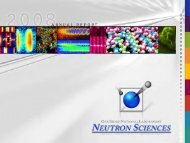Powder Diffraction - Spallation Neutron Source
Powder Diffraction - Spallation Neutron Source
Powder Diffraction - Spallation Neutron Source
You also want an ePaper? Increase the reach of your titles
YUMPU automatically turns print PDFs into web optimized ePapers that Google loves.
Resonant Conditions<br />
X-rays<br />
X-ray form factor has in fact three<br />
components:<br />
f(Q) + f’(λ) + i f”(λ)<br />
– f is determined by Q and the number<br />
of electrons in an atom and is<br />
independent of wavelength<br />
– f’ and f” are small except at<br />
wavelengths very close to an atom’s<br />
absorption edge<br />
At wavelengths close to an edge<br />
absorption becomes high;<br />
fluorescence occurs above the edge.<br />
Experiments are sometimes performed<br />
at wavelengths close to absorption<br />
edges to enhance the scattering from<br />
particular elements<br />
<strong>Neutron</strong>s<br />
Scattering lengths for most atoms are<br />
wavelength-independent.<br />
A few isotopes (mostly lanthanides and<br />
actinides) have adsorption edges at<br />
accessible wavelengths.<br />
This can be a problem with higher<br />
energy neutrons<br />
Some atoms scatter incoherently;<br />
Hydrogen (not deuterium) has a huge<br />
incoherent scattering cross-section<br />
that tends to overpower coherent<br />
scattering unless H is less than a few<br />
atom %<br />
18
















